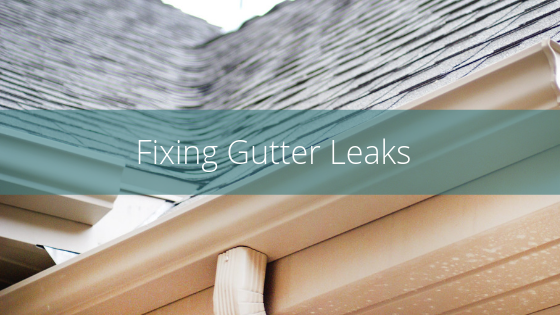
Gutters are vital to directing precipitation away from your foundation and therefore deserve your attention throughout the year. Generally, you should inspect your gutters at least twice annually (spring and fall are good times) to make sure they’re free of debris and are not leaking. Thankfully, fixing leaking gutters might not be too daunting. You can always call a professional, or you may be able to do it yourself. Here, you’ll find some of the most common sources of gutter leaks and how to fix them.
How to Fix Leaking Gutter Corners
When you see water seeping out of your gutter corner, you’re almost definitely dealing with the joint connection between the gutter and the downspout being the culprit.Clean the corner. Scrub it with a wire brush, apply an all-purpose cleaner, rinse with water and dry. Make sure the entire area is clean.
Caulk the joints. Use silicone caulk to fill in the area between the gutter and the downspout and press the joint connection together as tightly as you can. Remove excess caulk and apply another bead around the edges.
Silicone caulk adheres best to dry, warm metal. That’s why it’s important to clean and dry the gutters before applying caulk and, if possible, to do the repair on a warm day.How to Fix Holes in a Gutter
All gutter materials can be at risk for an occasional hole, whether due to rust or a puncture wound, but the good news is this is another rather easy fix. To fix holes in a gutter:Clean the area around the hole using the same methods we discussed above. Make sure you fully dry the area before the next step.
Apply roofing cement around the hole, then patch it with metal flashing.
Cover the flashing completely with more roofing cement.
Roofing cement, like caulk, works best on warm, dry metal.Re-Sealing Gutter Joints
When you have a leaking seam, you’ll most likely be able to see the evidence, whether it’s water coming down from the seam or a particularly wet spot on the ground below. If it’s not quite so obvious, check for debris in the gutter. If there are a bunch of leaves congregating near a particular seam, you’ve probably found the leak. Once you know where your leaking seam is, you can begin to repair it:Disconnect the seam. Usually, this will involve removing caulk and screws. After you’ve done that, the gutter pieces should come apart easily. If they don’t, you may have missed a screw.
Clean the seam using the same methods discussed earlier. Remove all caulk, dirt and any other buildup. You may want to repaint the area using a rust-resistant spray paint. If you do that, make sure the paint dries completely before you move on.
Apply caulk to the inner lip of the downhill and press the uphill on top and hold them together long enough to distribute the caulk properly. When you’re confident it’s back together with no leaks, replace any screws to complete the task.
Problems Requiring Replacement
While the above issues can be fixed fairly simply, there are some problems that might require you to consider new gutters. If your gutters are frequently separating or appear to be coming off the roof, or if your fasteners are falling off faster than you can replace them, you need to have that assessed right away. Likewise, if you notice water in your basement, it could be a sign of a serious issue with your gutters. If you notice any of that happening, give us a call and we’ll be happy to help diagnose what may be going on. Gutters are an important part of your home’s overall health. When you check them twice a year and fix any small issues before they become big problems, you’ll save a lot of money and a lot of headaches.Tags
Subscribe to West Michigan Roofing's Blog





Comments